Set up Local Testing
Learn how to set up Local Testing with BrowserStack App Accessibility.
To set up Local Testing, you need to either install the BrowserStack Local app or run the binary depending on the operating system and browser that you are using to access BrowserStack App Accessibility.
To understand why you need to install the BrowserStack Local app or run the binary, see Why do you need to install the BrowserStackLocal app?.
The Local Testing setup involves the following high-level steps:
Download and install BrowserStackLocal
The OS-browser combinations mentioned in the following sections are the OS and browser you are using to access BrowserStack Live, not the OS and browser you are going to open in the App Accessibility session for testing.
Chrome, Firefox, or Edge
Download BrowserStackLocal app installer
You can download the BrowserStackLocal app installer (BrowserStackLocal.msi) from the following sources:
After you download the installer or during the installation, you might get some security warnings depending on your organization’s security restrictions. You can still continue with the installation as the download links are secure. The installer is digitally signed, identifying the publisher as BrowserStack Ltd.
Direct download link:
Download the BrowserStack Local app
App Accessibility session: You can also download BrowserStackLocal.msi from the Local Testing option on the vertical toolbar.
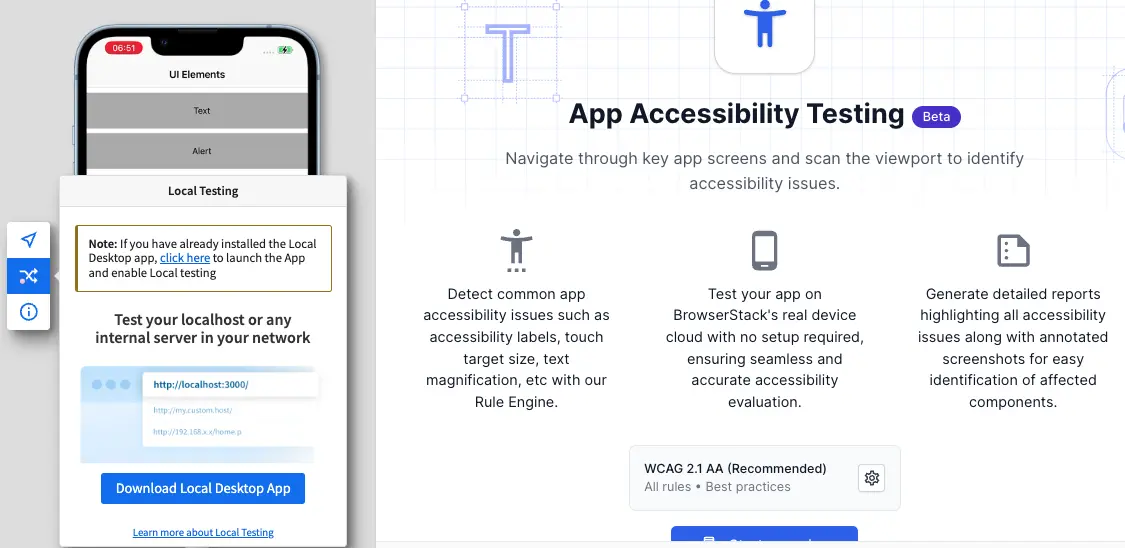
The BrowserStackLocal.msi package is downloaded to your default downloads folder.
Install BrowserStackLocal app
To install the BrowserStackLocal app, follow these steps:
-
Double-click the
BrowserStackLocal.msiinstaller file and follow the on-screen instructions.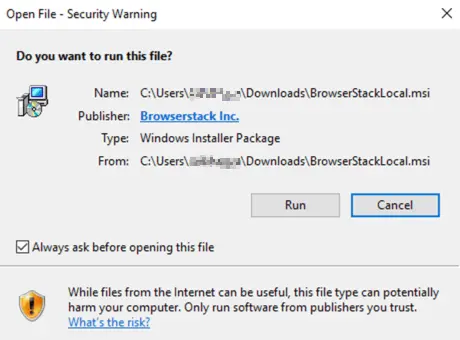
-
The summary screen confirms that the BrowserStackLocal app is installed. Click Finish to close the installer.
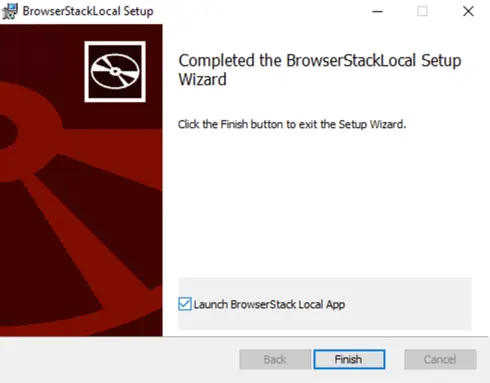
Other browsers
Download the BrowserStack Local binary for Windows.
After you download the binary or when you run the binary, you might get some security warnings depending on your organization’s security restrictions. You can still continue with the installation as the download links are secure. The binaries are digitally signed, identifying the publisher as BrowserStack Ltd.
Unzip the file to a folder/directory on your system, open the command-line interface, and navigate to the folder containing the Local binary.
Run the Local binary using the following command:
BrowserStackLocal.exe --key YOUR_ACCESS_KEY
Chrome, Firefox, or Edge
Download BrowserStackLocal app installer
You can download the BrowserStackLocal app installer (BrowserStackLocal.pkg) from the following sources:
After you download the installer or during the installation, you might get some security warnings depending on your organization’s security restrictions. You can still continue with the installation as the download links are secure. The installer is digitally signed, identifying the publisher as BrowserStack Ltd.
Direct download link:
Download the BrowserStack Local app
App Accessibility session: You can also download BrowserStackLocal.pkg from the Local Testing option on the vertical toolbar.

The BrowserStackLocal.pkg package is downloaded to your default download folder.
Install BrowserStackLocal app
To install the BrowserStackLocal app, follow these steps:
-
Double-click the
BrowserStackLocal.msiinstaller file and follow the on-screen instructions.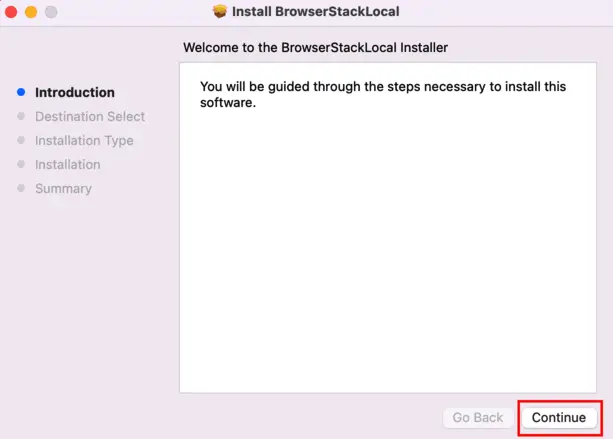
-
The Summary window confirms that the BrowserStackLocal app is installed. Click Close.
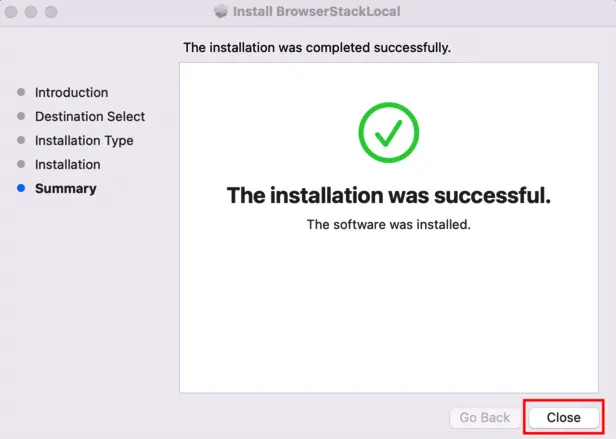
Other browsers
Download the BrowserStack Local binary for macOS/OS X.
After you download the binary or when you run the binary, you might get some security warnings depending on your organization’s security restrictions. You can still continue with the installation as the download links are secure. The binaries are digitally signed, identifying the publisher as BrowserStack Ltd.
Unzip the file to a folder/directory on your system, open the command-line interface, and navigate to the folder containing the Local binary.
Run the Local binary using the following command:
./BrowserStackLocal --key YOUR_ACCESS_KEY
A success message confirms that BrowserStackLocal is running on your system.
Download the appropriate BrowserStack Local binary for your system:
After you download the binary or when you run the binary, you might get some security warnings depending on your organization’s security restrictions. You can still continue with the installation as the download links are secure. The binaries are digitally signed, identifying the publisher as BrowserStack Ltd.
Unzip the file to a folder/directory on your machine, open the command-line interface, and navigate to the folder containing the Local binary.
Run the Local binary using the following command:
./BrowserStackLocal --key YOUR_ACCESS_KEY
A success message is shown on the terminal confirming that BrowserStackLocal is running.
For next steps, see Launch a Local Live session and Access your local application on App Accessibility.
Launch BrowserStackLocal app
This step is only applicable to the BrowserStackLocal app, and not the binary.
After the BrowserStack Local app is installed, it starts automatically and you are not required to do anything to start the BrowserStack Local app.
If the app does not start automatically, follow these steps to launch the BrowserStack Local app:
Select the search button on the taskbar and type BrowserStackLocal. Click the BrowserStackLocal app from the search results to launch it. If the app does not come up in the search results, you can find the app in the installation location you selected during the installation.
Open Finder. Then, go to the Applications folder and click the BrowserStackLocal app.
To know more about the options on the BrowserStack Local app, see BrowserStack Local app UI options.
Verify whether BrowserStackLocal app is running
This step is only applicable to the BrowserStackLocal app, and not the binary.
To verify whether the BrowserStackLocal app is running:
You can see the BrowserStack Local app icon in the Windows system tray.
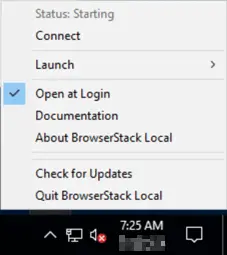
You can see the BrowserStack Local app icon in the top menu bar.

Connect the BrowserStackLocal app with App Accessibility
This step is only applicable to the BrowserStackLocal app, and not the binary.
If you do not have the App Accessibility dashboard or App Accessibility session open in your browser, open the dashboard to initiate the connection between the BrowserStackLocal app and App Accessibility.
If you already have the App Accessibility dashboard open or a App Accessibility session running in your browser, the BrowserStackLocal app automatically connects with App Accessibility.
If you face issues while connecting the BrowserStackLocal app on Google Chrome, you may need to manually grant your browser Local Network Access (LNA) permissions or disable the LNA check. For step-by-step instructions, see Troubleshooting app connectivity issues on Google Chrome.
On the BrowserStackLocal app, the status shows as Connected. The Connected status indicates that App Accessibility is now connected to BrowserStackLocal.
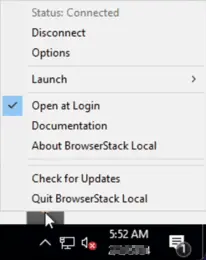

Launch an App Accessibility session
If you do not have a App Accessibility session running in your browser, open the App Accessibility dashboard and launch a App Accessibility session.
To launch a App Accessibility session, follow these steps:
- In your browser, open the App Accessibility dashboard.
- Select the device-browser combination to launch a App Accessibility session.
- Upload an app using the relevant source.
On the App Accessibility vertical toolbar, the green indicator beside the Local Testing option indicates that Local Testing is enabled for your session.
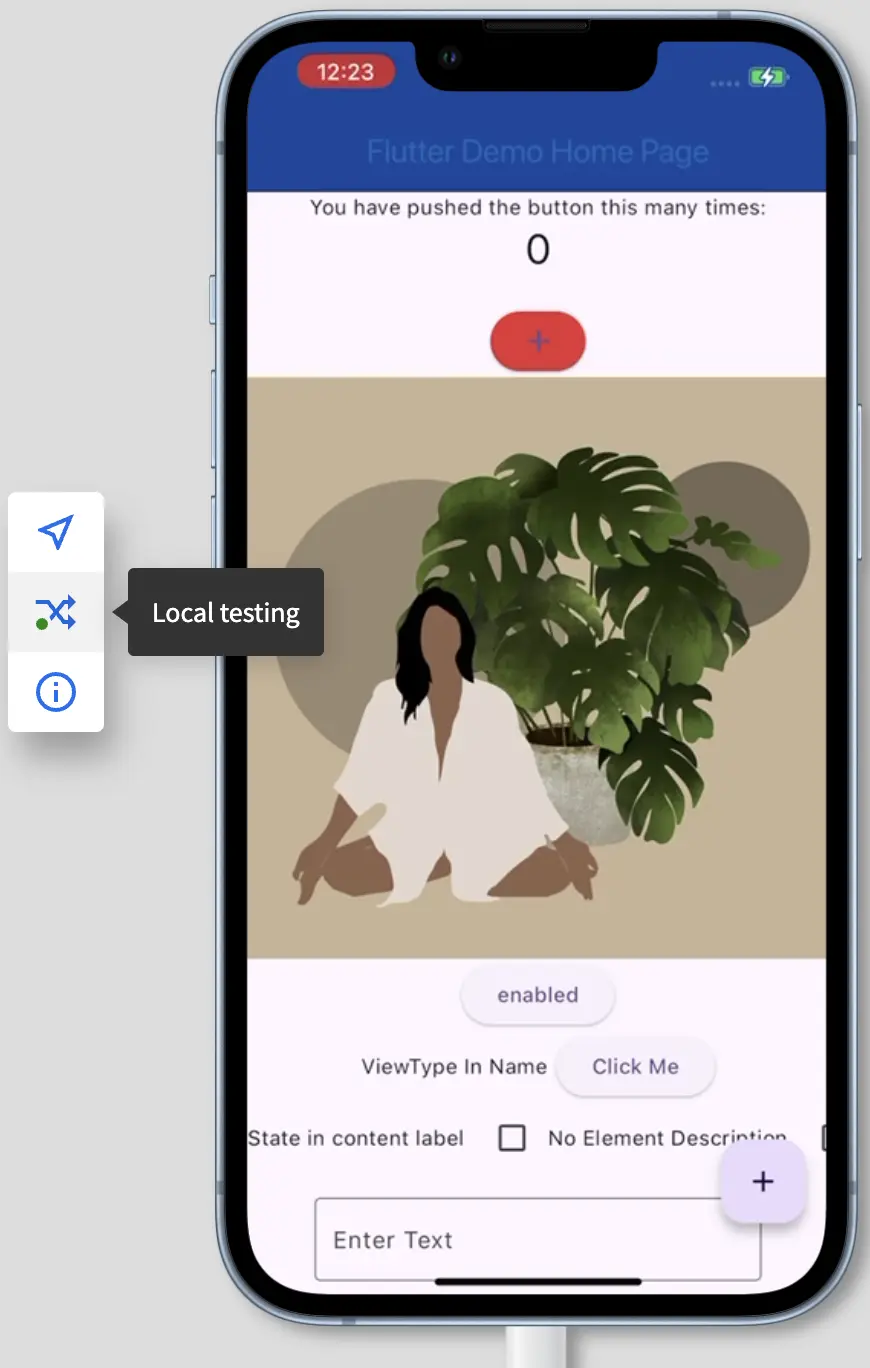
If you had a App Accessibility session already running before you connected BrowserStack Local with App Accessibility, then the session restarts with the Local settings. On the App Accessibility vertical toolbar, the Local Testing indicator becomes green. This indicates that Local Testing is enabled and ready for you to use.
Access your local application on App Accessibility
In the App Accessibility session, you can access and interact with your app as you would on a physical mobile device regardless of whether the app interacts with one or multiple servers.
Optionally, if your organization requires all the traffic to be routed through your network, select the Resolve all URLs through my network checkbox.

The localhost URL automatically changes to http://bs-local.com. If the localhost URL does not change automatically, replace localhost with bs-local.com manually. For example, instead of using localhost:3000, use bs-local.com:3000 to load your local website. Also, ensure that your local server is configured to serve requests from bs-local.com.
Next steps
- For advanced use cases such as VPN, Firewall, see Behind proxy, firewall or VPN?
We're sorry to hear that. Please share your feedback so we can do better
Contact our Support team for immediate help while we work on improving our docs.
We're continuously improving our docs. We'd love to know what you liked
We're sorry to hear that. Please share your feedback so we can do better
Contact our Support team for immediate help while we work on improving our docs.
We're continuously improving our docs. We'd love to know what you liked
Thank you for your valuable feedback!